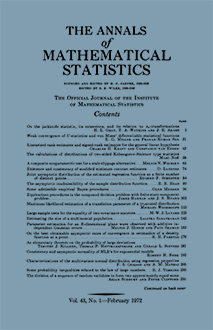Abstract
This investigation has been inspired by a paper of V. Fabian [3], where inter alia the applicability of stochastic approximation methods for progressive improvement of production processes is discussed; his non-formal discussion includes the case where the optimum of the production process moves during the optimization process. In the present paper, the last case is treated in a formal way. A modified approximation scheme is suggested, which turns out to be an adequate tool, when the position of the optimum is a linear (or nearly linear) function of time. The domain of effectiveness of the unmodified approximation scheme is also investigated. In this context, the incorrectness of a theorem of T. Kitagawa is pointed out. The considerations are performed for the Robbins-Monro case in detail; they can all be repeated for the Kiefer-Wolfowitz case and for the multidimensional case, as indicated in Section 4. Among the properties of the method, only the mean convergence and the order of magnitude of $E\lbrack (x_n - \theta_n)^2\rbrack$ are investigated; (here $x_n$ denotes the estimated and $\theta_n$ the true position of the optimum at time $n$.) A lemma, due to K. L. Chung [1] is used repeatedly: LEMMA. Let $b_n, n = 1, 2, \cdots$, be real numbers such that for $n \geqq n_0$, \begin{equation*}\tag{1}b_{n + 1} \leqq (1 - c/n^s)b_n + c'/n^t,\end{equation*} where $0 < s < 1, c > 0, c' > 0, t$ real. Then \begin{equation*}\tag{2}\lim \sup_{n \rightarrow \infty} n^{t - s}b_n \leqq c'/c.\end{equation*} The lemma remains true, if the inequalities (1) and (2) are reversed and, simultaneously, $\lim \sup_{n \rightarrow \infty}$ is changed into $\lim \inf_{n \rightarrow \infty}$. (In Chung's paper, a further assumption $t > s$ is made, but it is easily seen, that both versions of the lemma hold true also when $t \leqq s$; this fact is used in Section 3.) Throughout the paper, $K_0, K_1, K_2, \cdots$ denote positive constants, numbered in order of appearance.
Citation
Vaclav Dupac. "A Dynamic Stochastic Approximation Method." Ann. Math. Statist. 36 (6) 1695 - 1702, December, 1965. https://doi.org/10.1214/aoms/1177699797
Information





